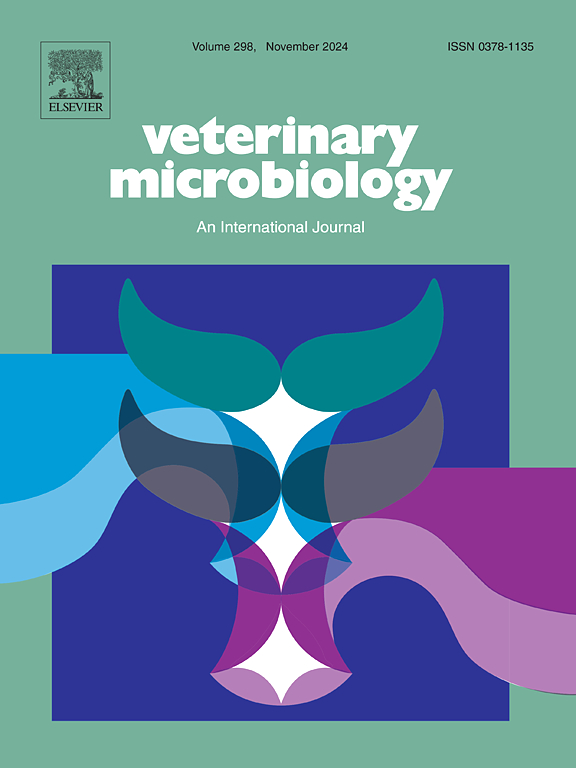Identification of conformational epitopes on VP1 of Senecavirus A by monoclonal antibodies and phage display
IF 2.7
2区 农林科学
Q3 MICROBIOLOGY
引用次数: 0
Abstract
Senecavirus A (SVA) has caused widespread outbreaks across various countries, leading to significant economic losses in the swine industry. Virus-neutralizing monoclonal antibodies (NAbs) play a crucial role in investigating host-virus interactions, facilitating vaccine development, and preventing SVA infections. In this study, eight NAbs targeting VP1 were generated, identifying seven distinct antigenic epitopes. Phage display was used to locate the epitopes of the prepared monoclonal antibodies. Using phage display technology, the epitopes recognized by these monoclonal antibodies were precisely mapped. The results showed that the epitope “SHHLGPAPHFLA” was identified by 6D26, with critical residues at H162, G165, P168, and F171. And the motif “HGAVRTGTWLAQ” was determined to bind 6D22, involving residues H162, G165, A172, G176, and W184. Three additional epitopes--“HTAIQPVAHPIV” (recognized by 4A1), “SSQSASWPAWLA” (4A2), and “NHPGSWISALDW” (4A20) --were also characterized. For 6D25, four potential binding sites (P132, L201, H211, R223) were identified, while 4A3 interacted with R166, L201, S203, T205, H211, W214, and Y218. Indirect immunofluorescence assay (IFA) confirmed that the selected conformational epitopes were effectively recognized by their respective monoclonal antibodies. These findings provide valuable insights for enriching our understanding of the B cell epitopes of SVA VP1 protein, and may contribute to SVA vaccine design, diagnostic approaches, and therapeutic strategies.
用单克隆抗体和噬菌体展示鉴定塞尼卡病毒A的VP1构象表位
塞内卡病毒A (SVA)在许多国家引起了广泛的爆发,给养猪业造成了重大的经济损失。病毒中和性单克隆抗体(nab)在研究宿主-病毒相互作用、促进疫苗开发和预防SVA感染方面发挥着至关重要的作用。在本研究中,生成了8个靶向VP1的nab,鉴定了7个不同的抗原表位。利用噬菌体展示技术对制备的单克隆抗体进行抗原表位定位。利用噬菌体展示技术,对这些单克隆抗体识别的表位进行了精确定位。结果表明,表位SHHLGPAPHFLA被6D26鉴定,关键残基位于H162、G165、P168和F171。确定基序“HGAVRTGTWLAQ”与6D22结合,涉及残基H162、G165、A172、G176和W184。另外三个表位-“HTAIQPVAHPIV”(被4A1识别),“SSQSASWPAWLA”(4A2)和“NHPGSWISALDW”(4A20) -也被表征。6D25鉴定出4个潜在结合位点(P132、L201、H211、R223),而4A3与R166、L201、S203、T205、H211、W214和Y218相互作用。间接免疫荧光分析(IFA)证实所选构象表位被各自的单克隆抗体有效识别。这些发现为丰富我们对SVA VP1蛋白B细胞表位的理解提供了有价值的见解,并可能有助于SVA疫苗的设计、诊断方法和治疗策略。
本文章由计算机程序翻译,如有差异,请以英文原文为准。
求助全文
约1分钟内获得全文
求助全文
来源期刊

Veterinary microbiology
农林科学-兽医学
CiteScore
5.90
自引率
6.10%
发文量
221
审稿时长
52 days
期刊介绍:
Veterinary Microbiology is concerned with microbial (bacterial, fungal, viral) diseases of domesticated vertebrate animals (livestock, companion animals, fur-bearing animals, game, poultry, fish) that supply food, other useful products or companionship. In addition, Microbial diseases of wild animals living in captivity, or as members of the feral fauna will also be considered if the infections are of interest because of their interrelation with humans (zoonoses) and/or domestic animals. Studies of antimicrobial resistance are also included, provided that the results represent a substantial advance in knowledge. Authors are strongly encouraged to read - prior to submission - the Editorials (''Scope or cope'' and ''Scope or cope II'') published previously in the journal. The Editors reserve the right to suggest submission to another journal for those papers which they feel would be more appropriate for consideration by that journal.
Original research papers of high quality and novelty on aspects of control, host response, molecular biology, pathogenesis, prevention, and treatment of microbial diseases of animals are published. Papers dealing primarily with immunology, epidemiology, molecular biology and antiviral or microbial agents will only be considered if they demonstrate a clear impact on a disease. Papers focusing solely on diagnostic techniques (such as another PCR protocol or ELISA) will not be published - focus should be on a microorganism and not on a particular technique. Papers only reporting microbial sequences, transcriptomics data, or proteomics data will not be considered unless the results represent a substantial advance in knowledge.
Drug trial papers will be considered if they have general application or significance. Papers on the identification of microorganisms will also be considered, but detailed taxonomic studies do not fall within the scope of the journal. Case reports will not be published, unless they have general application or contain novel aspects. Papers of geographically limited interest, which repeat what had been established elsewhere will not be considered. The readership of the journal is global.
 求助内容:
求助内容: 应助结果提醒方式:
应助结果提醒方式:


